Geology, Fluid Inclusions, and C–H–O–S–Pb Isotope Geochemistry of Pb–Zn Deposits within the Tuotuohe Region of the Tibetan Plateau: Implications for Ore Genesis
Abstract
1. Introduction
2. Geological Setting
3. Ore Deposits Geology
3.1. Host Rocks for Pb–Zn Mineralization
3.2. Ore-Controlling Structures
3.3. Ore Types and Mineral Assemblages
3.4. Stages of Mineralization
3.5. Wallrock Alteration
- (1)
- During stages 1 and 2 of mineralization, silicification takes many forms, forming irregular quartz veins and networks in stage 1 and planar alteration that is closely related to Pb–Zn mineralization in stage 2;
- (2)
- Barite alteration is characterized by the formation of variegated barite during stage 2 and by less abundant barite associated with gypsum in stage 3;
- (3)
- Carbonate alteration is associated with stages 2 and 3. The carbonate alteration that formed during stage 2 is more closely related to mineralization and is more voluminous than that which formed during stage 3, with the latter cross-cutting the former.
4. Sampling and Analytical Methods
5. Analytical Results
5.1. Fluid Inclusions
5.2. S Isotope Compositions
5.3. Pb Isotope Compositions
5.4. C and O Isotope Compositions
5.5. H and O Isotope Compositions
6. Discussion
6.1. Temperature, Density, and Salinity of Ore-Forming Fluids
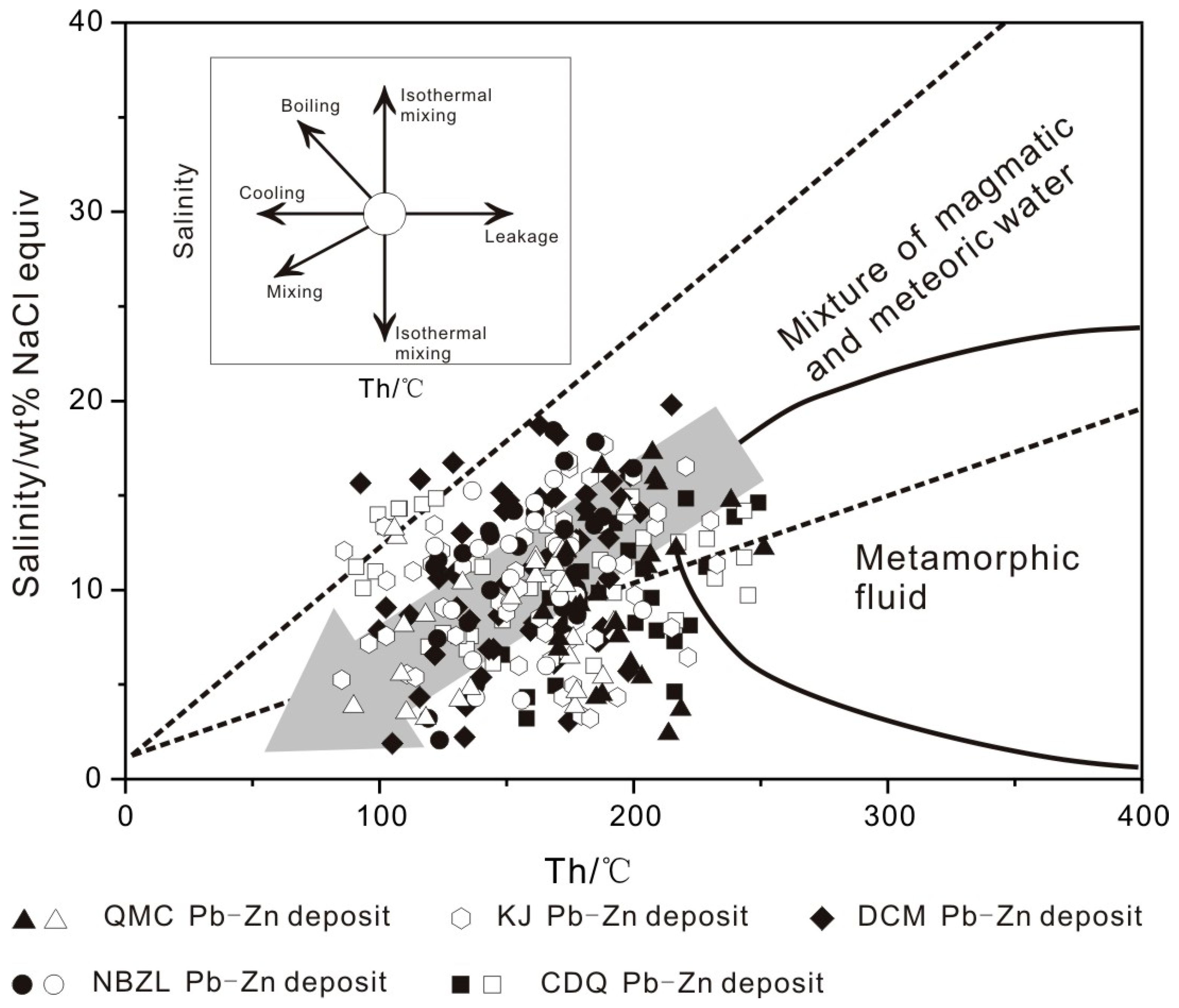
6.2. Sources of Ore-Forming Metals
6.3. Sources of Ore-Forming Fluid
6.4. Pb and Zn Transportation and Deposition Mechanisms
- (1)
- Cooling: Metal complex solubility is a function of temperature, and cooling reduces both solubility and stability, leading to the precipitation of sphalerite and galena. The study of the CDQ deposit by [34] shows that the temperature continues to decline as mineralization progresses, suggesting that cooling plays an important role;
- (2)
- Fluid mixing/dilution: Fluid mixing/dilution can lower the salinity of a fluid, reducing the concentrations of H+ and Cl− and decreasing the stability of metal complexes, leading to decomposition and precipitation, as follows:
- (3)
- Fluid–rock reactions: Sphalerite and galena can precipitate as a result of fluid–rock reactions that cause carbonate dissolution and the consequent Ca (+Mg) enrichment of hydrothermal fluids, as follows:
6.5. Mineral Deposit Type
7. Conclusions
- (1)
- The primary structural constraints on the location of Pb–Zn deposits within the Tuotuohe region are faults, although the deposits are primarily carbonate-hosted;
- (2)
- Fluid inclusion data for these deposits indicate that they formed from medium-low temperature, medium-low salinity, and low-density fluids;
- (3)
- Pb isotope compositions imply that the Pb within these deposits was derived from Cenozoic volcanics, and C-H-O-S isotope data indicate that the ore-forming fluid was a mixing of magmatic and meteoric water that was affected by wallrock interaction. Pb and Zn were transported in solution as chloride complexes and precipitated as a consequence of cooling, fluid mixing/dilution, and fluid–rock reactions;
- (4)
- The Pb–Zn deposits within the Tuotuohe region are magmatism-related medium-low temperature hydrothermal vein deposits.
Author Contributions
Funding
Data Availability Statement
Acknowledgments
Conflicts of Interest
References
- Hou, Z.Q.; Song, Y.C.; Li, Z.; Wang, Z.L.; Yang, Z.M.; Yang, Z.S.; Liu, Y.C.; Tian, S.H.; He, L.Q.; Chen, K.X.; et al. Thrust-controlled, sediments-hosted Pb-Zn-Ag-Cu deposits in eastern and northern margins of Tibetan orogenic belt: Geological features and tectonic model. Miner. Depos. 2008, 27, 123–144, (In Chinese with English Abstract). [Google Scholar]
- Dai, Z.X.; Bai, Y.; Wu, C.G.; Gu, F.; Zhu, M.Y.; Shang, X.Z. The Gold and Copper Mineralization in Western China and Its Adjacent Regions; Seismological Press: Beijing, China, 2001; p. 215. [Google Scholar]
- Deng, J.; Yang, L.Q.; Wang, C.M. Research advances of superimposed orogenesis and metallogenesis in the Sanjiang Tethys. Acta Petrol. Sin. 2011, 27, 2501–2509, (In Chinese with English Abstract). [Google Scholar]
- Hu, R.Z.; Turner, G.; Burnard, P.G.; Zhong, H.; Ye, Z.J.; Bi, X.W. Helium and argon isotopic geochemistry of Jinding superlarge Pb-Zn deposit. Sci. China Ser. D Earth Sci. 1998, 41, 442–448. [Google Scholar] [CrossRef]
- Huang, Z.L.; Li, W.B.; Chen, J.; Han, R.S.; Liu, C.Q.; Xu, C.; Guan, T. Carbon and oxygen isotope constraints on mantle fluidinvolvement in the mineralization of the Huize super-large Pb-Zn deposits, Yunnan Province, China. J. Geochem. Explor. 2003, 78, 637–642. [Google Scholar] [CrossRef]
- Song, Y.C.; Hou, Z.Q.; Yang, T.N.; Zhang, H.R.; Yang, Z.S.; Tian, S.H.; Liu, Y.C.; Wang, X.H.; Liu, Y.X.; Xue, C.D.; et al. Sediment-hosted Himalayan base metal deposits in Sanjiang region: Characteristics and genetic types. Acta Petrol. Et Mineral. 2011, 30, 355–380, (In Chinese with English Abstract). [Google Scholar]
- Wang, G.R.; Song, Y.C.; Zou, G.M.; Hou, Z.Q.; Yang, Z.S.; Yang, T.N.; Zhang, H.R.; Liu, Y.X.; Li, Z.; Wang, Y.K.; et al. History, current status, and next targets of exploration in the Chaqupacha Pb-Zn deposit, southern Qinghai Province. Acta Petrol. Et Miner. 2012, 31, 79–90. [Google Scholar]
- Liu, Y.C.; Hou, Z.Q.; Yang, Z.S.; Tian, S.H.; Song, Y.C.; Xue, W.W.; Wang, F.C.; Zhang, Y.B. Fluid inclusion constraints on the origin of Dongmozhazhua Pb-Zn ore deposit, Yushu area, Qinghai Province. Acta Petrol. Sin. 2010, 26, 1805–1819, (In Chinese with English Abstract). [Google Scholar]
- Liu, Y.C.; Yang, Z.S.; Hou, Z.Q.; Tian, S.H.; Wang, Z.L.; Song, Y.C.; Xue, W.W.; Lu, H.F.; Wang, F.C.; Zhang, Y.B.; et al. Geology and hydrogen, oxygen and carbon isotope geochemistry of Dongmozhazhua Pb-Zn ore deposit, Yushu area, Qinghai Province. Miner. Depos. 2009, 28, 770–784, (In Chinese with English Abstract). [Google Scholar]
- Tian, S.H.; Yang, Z.S.; Hou, Z.Q.; Gong, Y.L.; Liu, Y.C.; Song, Y.C.; Xue, W.W.; Lu, H.F.; Wang, F.C.; Zhang, Y.B. Rb-Sr and Sm-Nd isochron ages of Dongmozhazhua and Mohailaheng Pb-Zn ore deposits in Yushu area, southern Qinghai and their geological implications. Miner. Depos. 2009, 28, 747–758, (In Chinese with English Abstract). [Google Scholar] [CrossRef]
- Tian, S.H.; Yang, Z.S.; Hou, Z.Q.; Liu, Y.C.; Song, Y.C.; Wang, F.C.; Lu, H.F. Sulfur, lead, strontium and neodymium isotope compositions of the Dongmozhazhua lead-zinc ore deposit in the Yushu area, southern Qinghai: Implications for the sources of ore-forming material in the deposit. Acta Petrol. Sin. 2011, 27, 2173–2183, (In Chinese with English Abstract). [Google Scholar]
- Pan, G.T.; Xiao, Q.H.; Lu, S.N.; Deng, J.F.; Feng, Y.M.; Zhang, K.X.; Zhang, Z.Y.; Wang, F.G.; Xing, G.F.; Hao, G.J.; et al. Subdivision of tectonic units in China. Geol. China 2009, 36, 1–28, (In Chinese with English Abstract). [Google Scholar]
- Li, Y.L.; Wang, C.S.; Zhao, X.X.; Yin, A.; Ma, C. Cenozoic thrust system, basin evolution, and uplift of the Tanggula Range in the Tuotuohe region, central Tibet. Gondwana Res. 2012, 22, 482–492. [Google Scholar] [CrossRef]
- Liu, Y.X.; Hou, Z.Q.; Wang, G.H.; Jiang, X.J.; Li, Z.; Song, Y.C.; Wang, X.H. Basin evolutions of the Tuotuohe River basin and sedimentary response to the uplifting of the Qinghai-Tibet Plateau in the Paleogene-Neogene. Earth Sci. Front. 2011, 18, 65–76, (In Chinese with English Abstract). [Google Scholar]
- Mo, X.X.; Pan, G.T. From the Tethys to the formation of the Qinghai-Tibet Plateau: Constrained by tectono-magmatic events. Earth Sci. Front. 2006, 13, 43–51, (In Chinese with English Abstract). [Google Scholar]
- Pan, G.T.; Mo, X.X.; Hou, Z.Q.; Zhu, D.C.; Wang, L.Q.; Li, G.M.; Zhao, Z.D.; Geng, Q.R.; Liao, Z.L. Spatial-temporal framework of the Gangdese Orogenic Belt and its evolution. Acta Petrol. Sin. 2006, 22, 521–533, (In Chinese with English Abstract). [Google Scholar]
- Tapponnier, P.; Molnar, P. Slip-line field theory and large-scale continental tectonics. Nature 1976, 264, 319–324. [Google Scholar] [CrossRef]
- Molnar, P.; England, P.; Martinod, J. Mantle dynamics, uplift of the Tibetan Plateau, and the Indian monsoon. Rev. Geophys. 1993, 31, 357–396. [Google Scholar] [CrossRef]
- Luo, Z.H.; Mo, X.X.; Hou, Z.Q.; Deng, W.M.; Wang, J.H.; Zhao, Z.D.; Yu, X.H.; Li, J.P. An integrated model for the Cenozoic evolution of the Tibetan plateau: Constraints from igneous rocks. Earth Sci. Front. 2006, 13, 196–211, (In Chinese with English Abstract). [Google Scholar]
- Wu, F.Y.; Huang, B.C.; Ye, K.; Fang, A.M. Collapsed Himalayan-Tibetan orogen and the rising Tibetan Plateau. Acta Petrol. Sin. 2008, 24, 1–30, (In Chinese with English Abstract). [Google Scholar]
- Zhao, R.F.; Zhu, Y.T.; Zhou, Q.H.; Wang, M.C.; Li, J.X.; Sun, N.Y. Discovery of angular uncomformity below Triassic strata in the Yushu area, Qinghai. Geol. Bull. China 2004, 23, 616–619, (In Chinese with English Abstract). [Google Scholar]
- Qian, Y.; Tian, S.N.; Li, Y.J.; Sun, F.Y. Zircon U–Pb age and geochemical constraints on the origin and tectonic implication of the Tuotuohe Cenozoic alkaline magmatism in Qinghai–Tibet Plateau. Acta Geoc. 2020, 39, 67–84. [Google Scholar] [CrossRef]
- Qian, Y.; Sun, F.Y.; Li, B.L.; Li, S.J.; Zhao, J.W. Early Permian–Late Triassic magmatism in the Tuotuohe region of the Qinghai–Tibet plateau: Constraints on the tectonic evolution of the western segment of the Jinshajiang Suture. Acta Geol. Sin. (Engl. Ed.) 2014, 88, 498–516. [Google Scholar] [CrossRef]
- Sun, Y.G. Study on Ore-Controlling Structure Characteristics and Ore Genesis of Chuduoqu Lead-Zinc Mine in Tuotuohe Region, Qinghai Province. Master’s Thesis, Jilin University, Changchun, China, 2016. (In Chinese). [Google Scholar]
- Bodnar, R. Revised equation and table for determining the freezing point depression of H2O-NaCl solutions. Geochim. Et Cosmochim. Acta 1993, 57, 683–684. [Google Scholar] [CrossRef]
- Liu, B.; Shen, K. Thermodynamics of Fluid Inclusions; Geological Publishing House: Beijing, China, 1999; p. 290. [Google Scholar]
- Robinson, B.W.; Kusakabe, M. Quantitative preparation of sulfur dioxide, for sulfur-34/sulfur-32 analyses, from sulfides by combustion with cuprous oxide. Anal. Chem. 1975, 47, 1179–1181. [Google Scholar] [CrossRef]
- Li, Z. The Ore Forming Genesis Research of Chaqupacha Lead-Zinc Deposits in Qinghai Province Tuotuohe Area. Master’s Thesis, University of Science and Technology, Beijing, China, 2008; pp. 58–64, (In Chinese with English Abstract). [Google Scholar]
- Todt, W.; Cliff, R.; Hanser, A.; Hofmann, A. Re-calibration of NBS lead standards using a 202Pb + 205Pb double spike. Terra Abstr. 1993, 5, 396. [Google Scholar]
- Clayton, R.N.; Mayeda, T.K. The use of bromine pentafluoride in the extraction of oxygen from oxides and silicates for isotopic analysis. Geochim. Cosmochim. Acta 1963, 27, 43–52. [Google Scholar] [CrossRef]
- Friedman, I.; O’Neil, J.R. Compilation of stable isotope fractionation factors of geochemical interest. In Data of Geochemistry; Fleischer, M., Ed.; United States Geological Survey: Reston, VI, USA, 1977; pp. kk1–kk440. [Google Scholar]
- Shafaroudi, A.M.; Karimpour, M.H. Mineralogic, fluid inclusion, and sulfur isotope evidence for the genesis of Sechangi lead–zinc (–copper) deposit, Eastern Iran. J. Afr. Earth Sci. 2015, 107, 1–14. [Google Scholar] [CrossRef]
- Qu, G.Y.; Wang, K.Y.; Yang, H.; Sun, Q.F.; Li, J.; Cai, W.Y.; Lai, C.K. Fluid inclusions, H-O-S-Pb isotopes and metallogenic implications of Triassic Hua’naote Ag-Pb-Zn deposit (Inner Mongolia, China) in the eastern Central Asian Orogenic Belt. J. Geochem. Explor. 2021, 225, 106766. [Google Scholar] [CrossRef]
- Sun, Y.G.; Li, B.L.; Sun, F.Y.; Qian, Y.; Yu, R.T.; Zhao, T.F.; Dong, J.L. Ore Genesis of the Chuduoqu Pb-Zn-Cu Deposit in the Tuotuohe Area, Central Tibet: Evidence from Fluid Inclusions and C–H–O–S–Pb Isotopes Systematics. Minerals 2019, 9, 285. [Google Scholar] [CrossRef]
- Marques de Sá, C.; Noronha, F.; Cardellach, E.; Bobos, I. Fluid inclusion and (S, C, O, Pb) isotope study of Pb-Zn-(Cu-Ag) hydrothermal veins from Central and Northern Portugal—Metallogenic implications. Ore Geol. Rev. 2019, 112, 103043. [Google Scholar] [CrossRef]
- Zhang, Y.C.; Gao, S.B.; Zheng, Y.Y.; Jiang, J.S.; Zhang, S.Z.; Jiang, X.J.; Guo, X.R. Mineralogy, fluid inclusions and C–H–O–S–Pb isotopes of the Palaeocene Longgen Pb-Zn deposit in the western Nyainqentanglha belt, Tibet. Ore Geol. Rev. 2018, 102, 18–43. [Google Scholar] [CrossRef]
- Yu, G.Y.; Li, S.D.; Wang, Y.C.; Wang, K.Y. Fluid Evolution and Ore Genesis of the Qibaoshan Polymetallic Ore Field, Shandong Province, China: Constraints from Fluid Inclusions and H–O–S Isotopic Compositions. Minerals 2019, 9, 394. [Google Scholar] [CrossRef]
- Yang, S.S.; Wang, H.; Zhu, X.Y.; Zou, T.; Yang, C.L.; Jiang, H.Y.; Jiang, B.B.; Cheng, X.Y.; Li, Y.J. The Metallogenic Mechanism of Skarn Sn-Polymetallic Deposits in the Southern Great Khingan Range, China: Constraints on the Geological and Geochemical Characteristics of Damogutu Sn–Fe and Dashishan Sn–Pb–Zn Deposits. Minerals 2019, 9, 418. [Google Scholar] [CrossRef]
- Li, S.D.; Chen, C.; Gao, L.L.; Xia, F.; Zhang, X.B.; Wang, K.Y.; Arkin, K. Ore Genesis of the Kuergasheng Pb–Zn Deposit, Xinjiang Province, Northwest China: Constraints from Geology, Fluid Inclusions, and H–O–C–S–Pb Isotopes. Minerals 2020, 10, 592. [Google Scholar] [CrossRef]
- Ke, L.L.; Zhang, H.Y.; Liu, J.J.; Zhai, D.G.; Guo, D.H.; Yang, J.K.; Tan, Q.; Xu, Y.W.; Zhang, M.; Wang, S.G. Fluid Inclusion, H-O, S, Pb and noble gas isotope studies of the Aerhada Pb-Zn-Ag deposit, Inner Mongolia, NE China. Ore Geol. Rev. 2017, 88, 304–316. [Google Scholar] [CrossRef]
- Borojević Šoštarić, S.; Palinkaš, L.A.; Neubauer, F.; Hurai, V.; Cvetković, V.; Roller-Lutz, Z.; Mandić, M.; Genser, J. Silver-base metal epithermal vein and listwanite hosted deposit Crnac, Rogozna Mts., Kosovo, part II: A link between magmatic rocks and epithermal mineralization. Ore Geol. Rev. 2013, 50, 98–117. [Google Scholar] [CrossRef]
- Shepherd, T.J.; Rankin, A.H.; Alderton, D.H.M. A Practical Guide to Fluid Inclusion Studies; Blackie and Son Ltd.: London, UK, 1985. [Google Scholar]
- Conliffe, J.; Wilton, D.H.C.; Blamey, N.J.F.; Archibald, S.M. Paleoproterozoic Mississippi Valley Type Pb–Zn mineralization in the Ramah Group, Northern Labrador: Stable isotope, fluid inclusion and quantitative fluid inclusion gas analyses. Chem. Geol. 2013, 362, 211–223. [Google Scholar] [CrossRef]
- Liu, H.G. Research on provenance of MVT Pb-Zn deposits. IOP Conf. Ser. Mater. Sci. Eng. 2017, 207, 012108. [Google Scholar] [CrossRef]
- Wu, T.; Huang, Z.L.; He, Y.F.; Yang, M.; Fan, H.F.; Wei, C.; Ye, L.; Hu, Y.S.; Xiang, Z.H.; Lai, C.K. Metal source and ore-forming process of the Maoping carbonate-hosted Pb-Zn deposit in Yunnan, SW China: Evidence from deposit geology and sphalerite Pb-Zn-Cd isotopes. Ore Geol. Rev. 2021, 135, 104214. [Google Scholar] [CrossRef]
- Liu, Y.C.; Song, Y.C.; Hou, Z.Q.; Xi, D.P.; Li, S.P.; Yue, L.L.; Ma, W.; Tang, B.L. Palynological constraints on the age of the Mississippi Valley-type Changdong Pb-Zn deposit, Sanjiang belt, West China. Sci. China Earth Sci. 2021, 65, 167–181. [Google Scholar] [CrossRef]
- Zhong, R.C.; Brugger, J.; Chen, Y.J.; Li, W.B. Contrasting regimes of Cu, Zn and Pb transport in ore-forming hydrothermal fluids. Chem. Geol. 2015, 395, 154–164. [Google Scholar] [CrossRef]
- Saeidabadi, Z.K.; Karimpour, M.H.; Shafaroudi, A.M.; Rahimi, B.; Corfu, F. Origin of the Kaviro lead deposit in the Neyganan area, Lut Block, Eastern Iran: Constraints from geology, fluid inclusions, and isotope geochemistry. J. Geochem. Explor. 2018, 192, 85–102. [Google Scholar] [CrossRef]
- Zartman, R.; Doe, B. Plumbotectonics—The model. Tectonophysics 1981, 75, 135–162. [Google Scholar] [CrossRef]
- Stacey, J.S.; Kramers, J. Approximation of terrestrial lead isotope evolution by a two-stage model. Earth Planet. Sci. Lett. 1975, 26, 207–221. [Google Scholar] [CrossRef]
- Wang, R.L.; Zeng, Q.D.; Zhang, Z.C.; Guo, Y.P.; Zhang, Z.; Zhou, L.L.; Wang, X.W.; Yu, B. Genesis of the Aobaotu Pb–Zn deposit in the southern Great Xing’an Range, NE China: Constraints from geochronology and C–H–O–S–Pb isotopic and fluid inclusion studies. Geol. J. 2022, 57, 1391–1412. [Google Scholar] [CrossRef]
- Zhao, Z.D.; Mo, X.X.; Dong, G.C.; Zhou, S.; Zhu, D.C.; Liao, Z.L.; Sun, C.G. Pb isotopic Geochemistry of Tibetan Plateau and its implications. Geoscience 2007, 21, 265–274, (In Chinese with English Abstract). [Google Scholar]
- Zhu, B.Q. The Theory and Application of the Isotopic Systematic in Geoscience Concurrent Discussion of the Continental Crust and Mantle Evolvement in China; Science Publishing House: Beijing, China, 1998; p. 330. [Google Scholar]
- Hoefs, J. Stable Isotope Geochemistry; Springer: Berlin/Heidelberg, Germany, 2009; p. 285. [Google Scholar]
- Harris, A.C.; Golding, S.D.; White, N.C. Bajo de la Alumbrera copper-gold deposit: Stable isotope evidence for a porphyry-related hydrothermal system dominated by magmatic aqueous fluids. Econ. Geol. 2005, 100, 863–886. [Google Scholar] [CrossRef]
- Sun, G.T.; Zeng, Q.D.; Zhou, J.X.; Zhou, L.L.; Chen, P.W. Genesis of the Xinling vein-type Ag-Pb-Zn deposit, Liaodong Peninsula, China: Evidence from texture, composition and in situ S-Pb isotopes. Ore Geol. Rev. 2021, 133, 104120. [Google Scholar] [CrossRef]
- Schwarcz, H.; Burnie, S. Influence of sedimentary environments on sulfur isotope ratios in clastic rocks: A review. Miner. Depos. 1973, 8, 264–277. [Google Scholar] [CrossRef]
- Hao, H.D.; Song, Y.C.; Li, L.S.; Jia, Z.Y.; Wang, Y.K.; Liu, Q. Characteristics of Breccias and C-O-Sr-S Isotope Geochemistry of the Duocaima Pb-Zn Deposit in Tuotuohe, Qinghai Province: Implications for the Ore-forming Process. Acta Geol. Sin. Engl. Ed. 2015, 89, 1568–1587. [Google Scholar]
- Yao, F.L.; Sun, F.Y. (Eds.) Mineralogy Tutorial; Geological Publishing House: Beijing, China, 2005. (In Chinese) [Google Scholar]
- Taylor, H.P. The Application of Oxygen and Hydrogen Isotope Studies to Problems of Hydrothermal Alteration and Ore Deposition. Econ. Geol. 1974, 69, 843–883. [Google Scholar] [CrossRef]
- Taylor, H.P., Jr.; Frechen, J.; Degens, E.T. Oxygen and carbon isotope studies of carbonatites from the Laacher See district, West Germany and the Alnö district, Sweden. Geochim. Et Cosmochim. Acta 1967, 31, 407–430. [Google Scholar] [CrossRef]
- Li, Y.; Ren, Y.S.; Hao, Y.J.; Yang, Q. Ore-forming fluid characteristics and genesis of vein-type lead-zinc mineralization of Xiaohongshilazi deposit, Jilin Province, China. Glob. Geol. 2017, 20, 191–199. [Google Scholar]
- Liu, Y.F.; Qi, H.W.; Bi, X.W.; Hu, R.Z.; Qi, L.K.; Yin, R.S.; Tang, Y.Y. Two types of sediment-hosted Pb-Zn deposits in the northern margin of Lanping basin, SW China: Evidence from sphalerite trace elements, carbonate C-O isotopes and molybdenite Re-Os age. Ore Geol. Rev. 2021, 131, 104016. [Google Scholar] [CrossRef]
- Fareeduddin; Venkatesh, B.R.; Hanumantha, R.; Golani, P.R.; Sharma, B.B.; Neogi, S. Petrology and Stable Isotope (S, C, O) Studies of Selected Sedimenthosted Basemetal Ore Deposits in the Proterozoic Aravalli-Delhi Fold Belt, Rajasthan. J. Geol. Soc. India 2014, 83, 119–141. [Google Scholar] [CrossRef]
- Veizer, J.; Hoefs, J. The nature of 18O/16O and 13C/12C secular trends in sedimentary carbonate rocks. Geochim. Et Cosmochim. Acta 1976, 40, 1387–1395. [Google Scholar] [CrossRef]
- Landtwing, M.; Pettke, T.; Halter, W.; Heinrich, C.; Redmond, P.; Einaudi, M.; Kunze, K. Copper deposition during quartz dissolution by cooling magmatichydrothermal magmatic-hydrothermal fluids: The Bingham porphyry. Earth Planet. Sci. Lett. 2005, 235, 229–243. [Google Scholar] [CrossRef]
- O’Neil, J.R.; Silberman, M.L. Stable isotope relations in epithermal Au-Ag deposits. Econ. Geol. 1974, 69, 902–909. [Google Scholar] [CrossRef]
- Beane, R.; Titley, S. Porphyry copper deposits; Part II: Hydrothermal alteration and mineralization. Econ. Geol. 1981, 75, 235–269. [Google Scholar]
- Sawkins, F.J. Sulfide ore deposits in relation to plate tectonics. J. Geol. 1972, 80, 377–397. [Google Scholar] [CrossRef]
- Benedezú, R.; Fonteboté, L. Cordilleran Epithermal Cu-Zn-Pb-(Au-Ag) Mineralization in the Colquijirca District, Central Peru: Deposit-Scale Mineralogical Patterns. Econ. Geol. 2009, 104, 905–944. [Google Scholar] [CrossRef]
- Kissin, S.A.; Mango, H. Silver vein deposits. In Treatise on Geochemistry, 2nd ed.; Elsevier: Oxford, UK, 2014; pp. 425–432. [Google Scholar]
- Sibson, R.H.; Robert, F.; Poulsen, K.H. High angle reverse faults, fluid-pressure cycling, and mesothermal gold-quartz deposits. Geology 1988, 16, 551–555. [Google Scholar] [CrossRef]
- Wu, J.; Li, Z.; Zhu, M.J.; Huang, W.T.; Liao, J.; Zhang, J.; Liang, H.Y. Genesis of the Beixiang Sb-Pb-Zn-Sn Deposit and Polymetallic Enrichment of the Danchi Sn-Polymetallic Ore Belt in Guangxi, SW China. Minerals 2022, 12, 1349. [Google Scholar] [CrossRef]



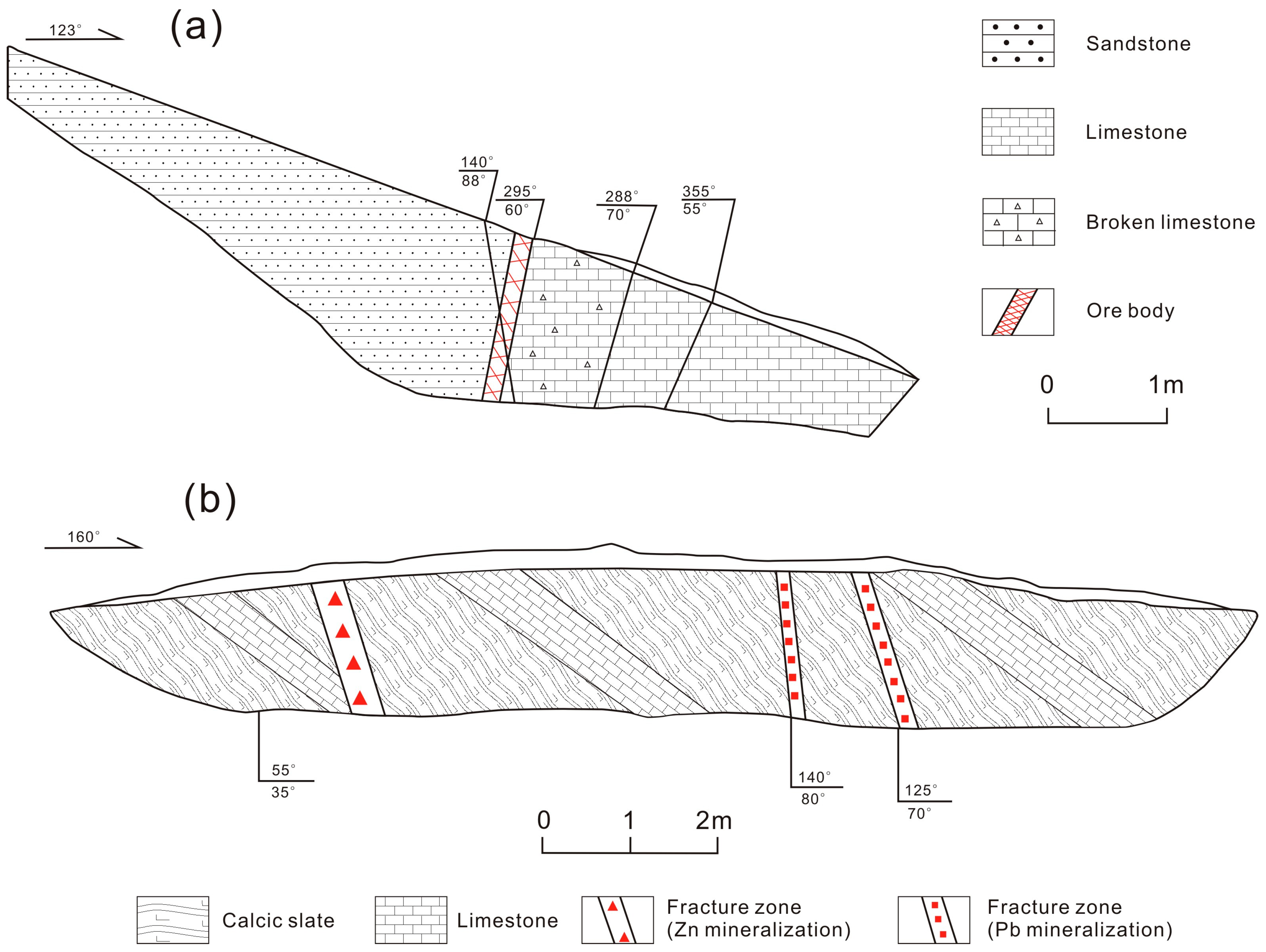


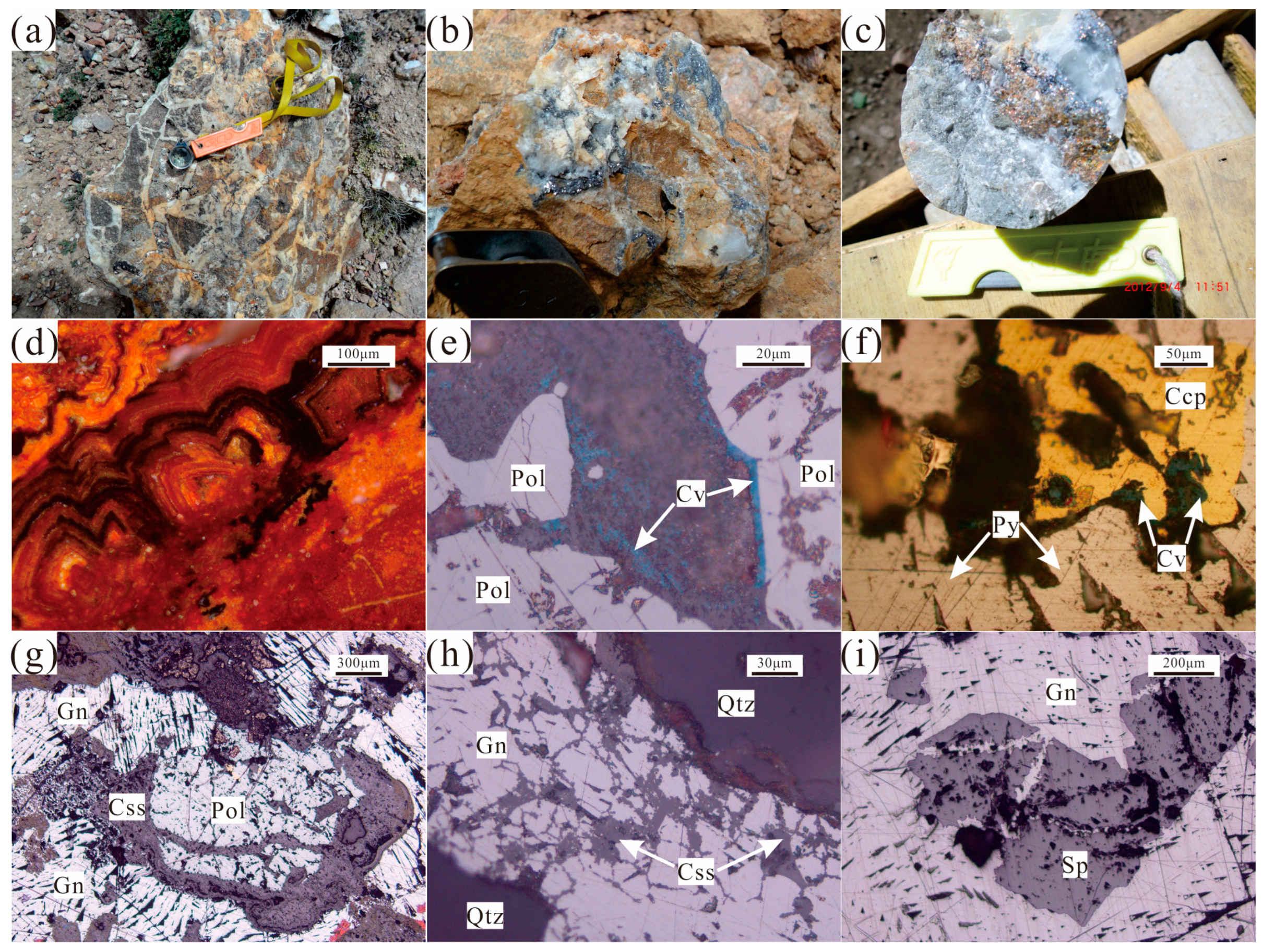
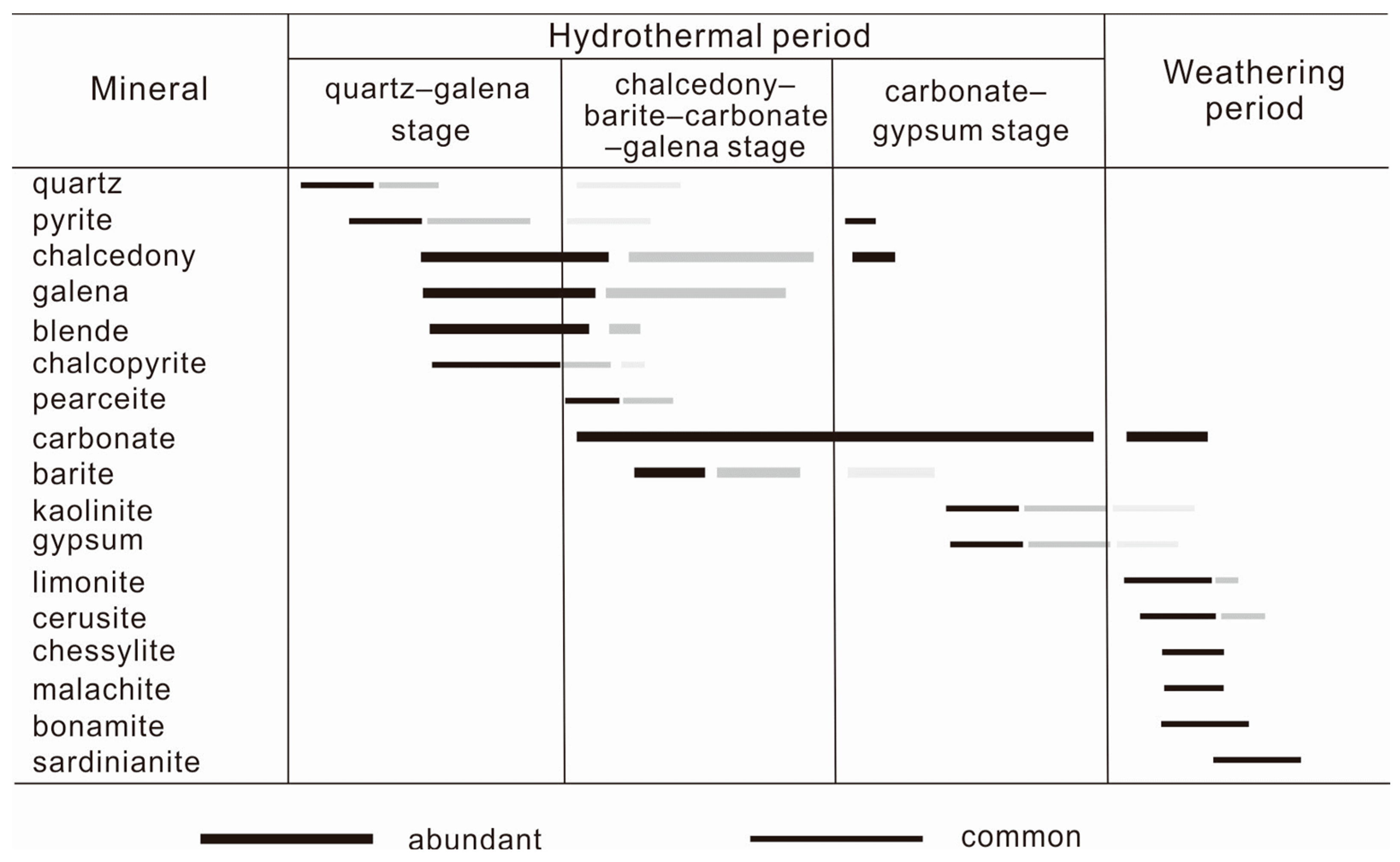
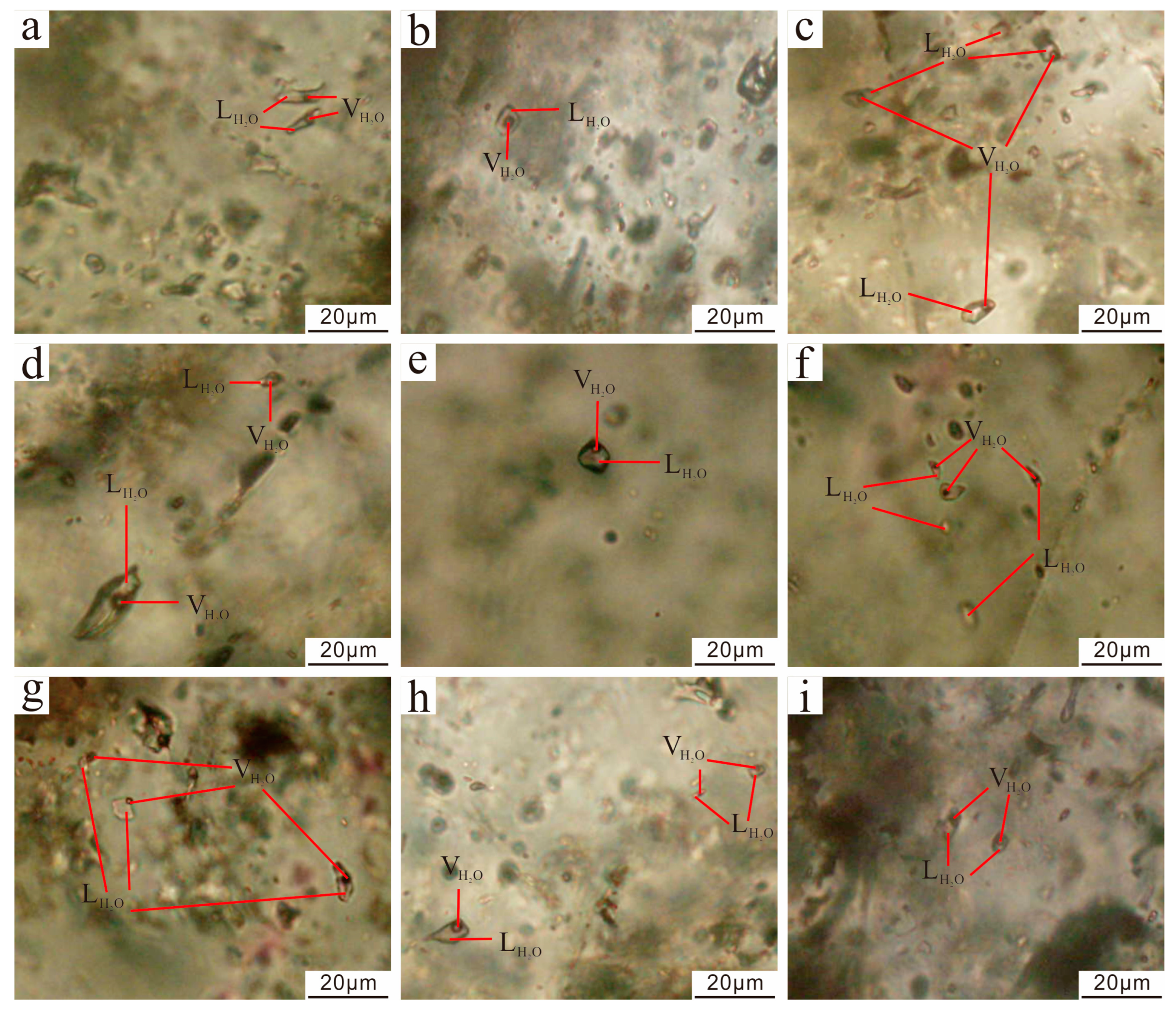


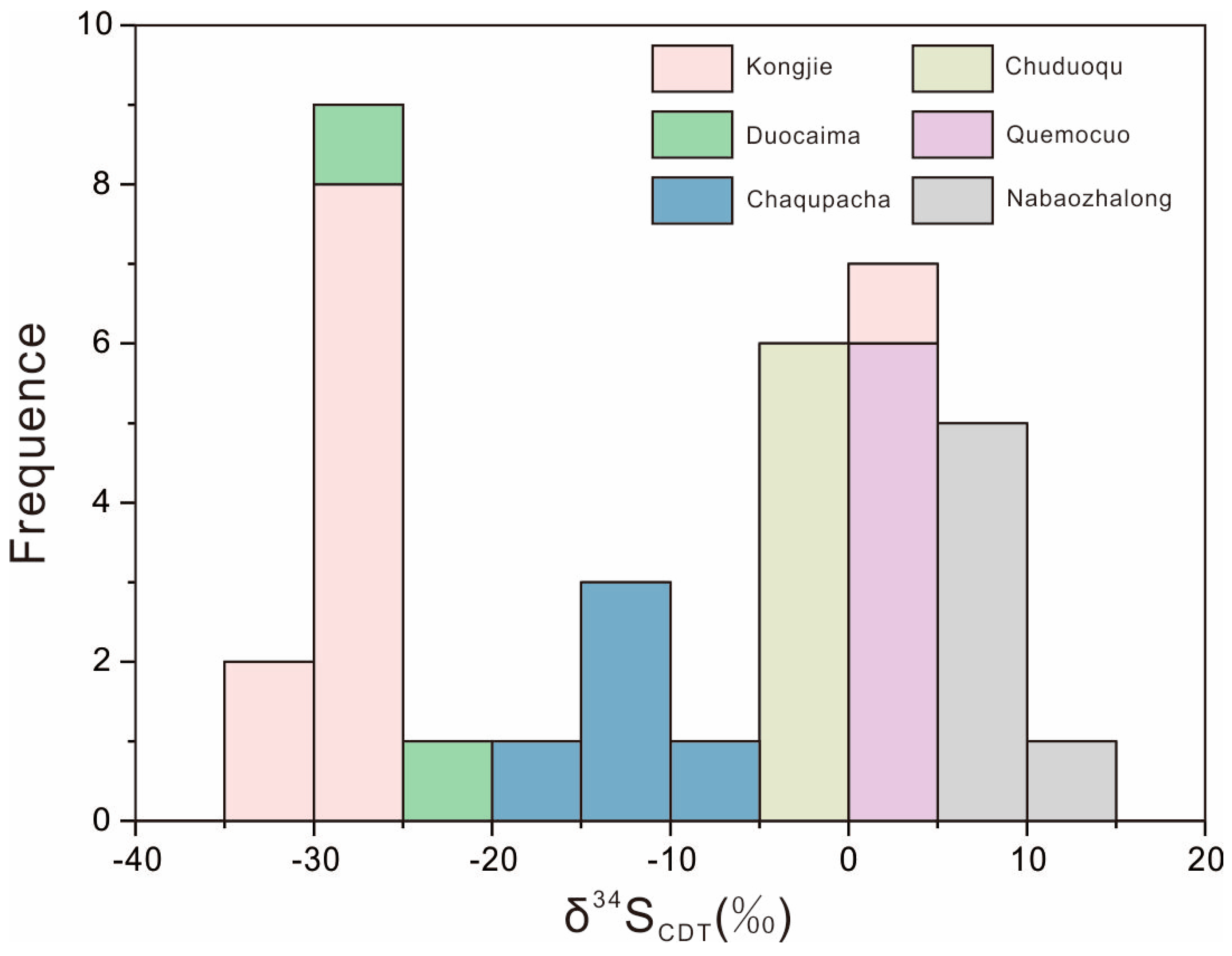


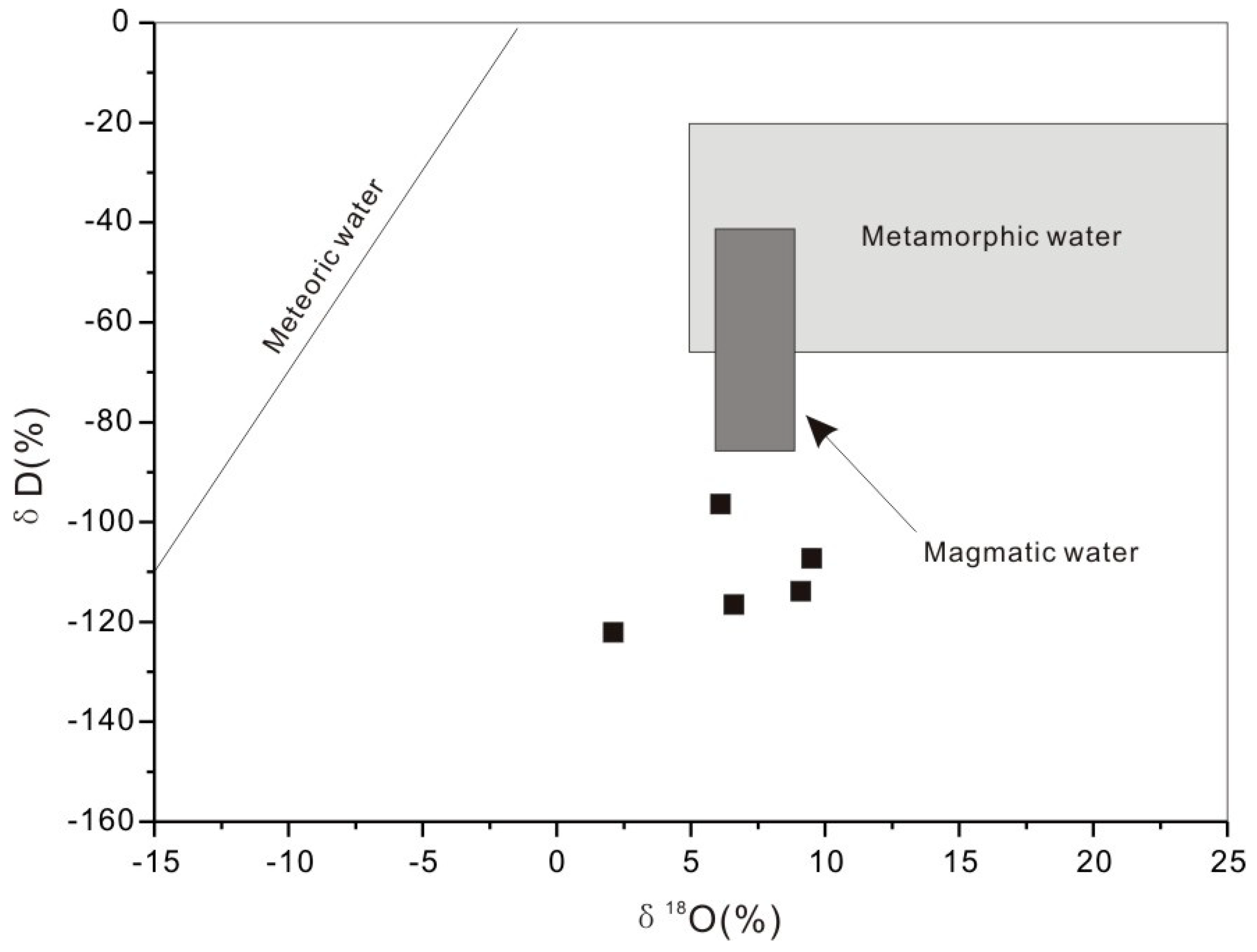

| Ore-Bearing Wallrock | Ore Bodies | Ore-Controlling Structure | Ore Types and Mineral Assemblages | Wallrock Alteration | |
|---|---|---|---|---|---|
| Duocaima | The Jiushidaoban Formation limestones, the Wudaoliang Formation limestones | Veined, lenticular | The NW fault fracture zone | Brecciated, veinlet, poikilitic, and impregnation structures; galena, sphalerite, pyrite, sardinianite, smithsonite, limonite, etc. | Carbonation, silicification, argillization |
| Chuduoqu | The Buqu Formation limestones | Veined | The NW fault fracture zone primarily, and near NS interformational fracture zone secondly | Galena, chalcopyrite, sphalerite, cerusite, limonite, pyrite, covellite, etc.; veinlet, massive, and brecciated structures | Baratization, carbonation, silicification, argillization |
| Nabaozhalong | The Bolila Formation grain limestones | Veined | The circular structure | Massive, brecciated, veinlet, and impregnation structures; galena, sphalerite, pyrite, malachite, etc. | Carbonation, silicification, kaolinization |
| Kongjie | The Zharigen Formation bioclastic limestones | Veined | The NW fault fracture zone | Galena, sphalerite, limonite, pyrite, etc.; massive, and impregnation structures | Carbonation, silicification |
| Quemocuo | The Labochari Formation micrite and bioclastic limestones | Veined, lenticular | The NNE fault fracture zone | Galena, sphalerite, etc.; massive, brecciated, veinlet, and impregnation structures | Carbonation, silicification, baratization |
| Sample | Host | Tm Ice/°C | Th/°C | Salinity/wt.% NaCl eq. |
|---|---|---|---|---|
| DCM | ||||
| SJ1-7 | Quartz | −1.3–−14 | 115.8–187.8 (14) | 2.23–18.19 |
| SJ1-8-1 | Quartz | −5–−12 | 115.9–199.3 (12) | 3.05–15.85 |
| SJ1-9 | Quartz | −4.6–−13 | 118.9–211 (7) | 7.30–16.72 |
| SJ1-13-1 | Quartz | −1.1–−16 | 105–214.8 (8) | 1.90–19.79 |
| SJ1-18 | Quartz | −2.3–−12 | 102.5–203.1 (10) | 3.85–15.75 |
| SJ1-16 | Quartz | −5.4–−15 | 122.1–247.6 (12) | 8.4–16.34 |
| SJ1-10 | Quartz | −7.3–−12 | 121.3–195.5 (11) | 10.87–15.65 |
| CDQ | ||||
| SJ1-46 | Calcite | −4.4–−11 | 93.4–240.5 (12) | 7.01–14.94 |
| SJ1-47 | Calcite | −3.8–−10 | 98.4–231.9 (13) | 6.14–14.31 |
| SJ1-50 | Calcite | −6.7–−7.6 | 90.8–179.1 (9) | 10.11–11.23 |
| SJ1-51 | Calcite | −3.7–−10 | 99.4–217.6 (6) | 5.99–14.31 |
| SJ1-52 | Calcite | −4.8–−11 | 98.1–243.5 (12) | 7.58–14.84 |
| SJ1-53 | Quartz | −4.1–−7.4 | 145.8–21.64 (9) | 6.58–10.99 |
| CDQ-B3 | Quartz | −4.6–−10.6 | 167–249 (4) | 7.3–14.6 |
| CDQ-B11 | Quartz | −5.5–−10.8 | 176.6–239.7 (12) | 8.54–14.8 |
| CDQ-B12 | Quartz | −2.6–−9.6 | 158–228.6 (5) | 3.2–13.55 |
| CDQ-B13 | Quartz | −5.1–−8 | 148.4–248.2 (3) | 8.4–11.7 |
| CDQ-W4 | Quartz | −7.9–−8.9 | 178–228.7 (2) | 11.5–12.07 |
| KJ | ||||
| SJ1-22-1 | Quartz | −3.9–−13.7 | 102.3–199.8 (12) | 6.29–17.65 |
| SJ1-22-2 | Quartz | −6.7–−10.1 | 98.4–197.7 (13) | 10.49–13.44 |
| SJ1-22-3 | Quartz | −2–−12.4 | 132.8–197.2 (9) | 4.32–16.44 |
| SJ1-23-1 | Quartz | −6.4–−12.5 | 91.8–220.5 (11) | 7.58–16.53 |
| SJ1-24 | Quartz | −2.6–−9.4 | 91.4–236.4 (16) | 4.32–13.33 |
| SJ1-25 | Quartz | −3–−10.1 | 85.1–209.6 (7) | 4.94–14.10 |
| SJ1-26 | Quartz | −3.3–−9.7 | 86.2–232.7 (8) | 5.4–13.66 |
| SJ1-27 | Quartz | −5.4–−12.8 | 174.5–196 (3) | 8.4–16.82 |
| QMC | ||||
| QH11-58 | Quartz | −3.8–−10.7 | 164.4–259.5 (5) | 6.14–14.73 |
| QH11-60 | Quartz | −2.6–−8.3 | 170.5–203.2 (9) | 4.32–12.07 |
| SJ1-40 | Quartz | −2.7–−13.3 | 162.6–207.3 (12) | 4.48–17.28 |
| SJ1-41 | Quartz | −1.4–−12.5 | 187.5–219.3 (3) | 2.4–16.53 |
| SJ1-42 | Quartz | −2.2–−10 | 170.6–218.5 (7) | 3.69–13.99 |
| SJ1-43 | Calcite | −2.3–−8.9 | 76–187.9 (8) | 3.85–12.77 |
| SJ1-38 | Calcite | −2.8–−9.3 | 105.9–177.6 (9) | 4.63–13.22 |
| SJ1-44 | Calcite | −3.4–−10.3 | 75.9–197.3 (7) | 5.55–14.31 |
| SJ1-39 | Calcite | −2.3–−6.3 | 89.8–192.2 (10) | 3.85–9.60 |
| QH11-56 | Calcite | −1.9–−5.6 | 110.5–131.5 (4) | 3.21–8.67 |
| NBZL | ||||
| QH11-61 | Calcite | −7.1–−8.6 | 93.4–189.7 (4) | 10.62–12.42 |
| QH11-62 | Calcite | −3.9–−8.5 | 97.3–213.4 (6) | 6.29–12.31 |
| QH11-63 | Calcite | −6.1–−11.8 | 126.4–168.6 (7) | 9.34–15.85 |
| QH11-69 | Calcite | −2.5–−8.5 | 155.9–181.2 (9) | 4.17–12.31 |
| NBZLZK005-W10 | Calcite | −2.6–−10.6 | 121.8–232.5 (4) | 4.32–14.63 |
| NBZLZK005-W11 | Quartz | −5.6–−10.1 | 123.0–207.6 (12) | 8.27–13.88 |
| QH11-67 | Quartz | −9–−14.6 | 117.9–199.9 (12) | 12.88–18.45 |
| QH11-68 | Quartz | −4.7–−9.5 | 120.4–184.4 (13) | 7.44–13.44 |
| QH11-70 | Quartz | −3–−13.9 | 119.2–204.7 (9) | 3.21–17.83 |
| Sample | 208Pb/204Pb | 207Pb/204Pb | 206Pb/204Pb | Δβ | Δγ | δ34S V-CDT/‰ |
|---|---|---|---|---|---|---|
| CDQ | ||||||
| CDQ-B13 | 38.858 | 15.664 | 18.689 | 15.165 | 32.634 | −3.8 |
| CDQ-B14 | 38.904 | 15.682 | 18.687 | 16.332 | 33.856 | −2.4 |
| CDQ-B19 | 38.932 | 15.689 | 18.695 | 16.785 | 34.600 | −1.9 |
| CDQ-W2 | 38.81 | 15.651 | 18.655 | 14.323 | 31.358 | −1.9 |
| CDQ-B20 | 38.937 | 15.692 | 18.692 | 16.980 | 34.733 | −1.3 |
| CDQ-B21 | 38.943 | 15.694 | 18.694 | 17.110 | 34.892 | −1.7 |
| KJ | ||||||
| KJ-B3 | 38.895 | 15.663 | 18.766 | 15.100 | 33.617 | −28.7 |
| KJ-B4 | 38.968 | 15.674 | 18.81 | 15.813 | 35.557 | −29.4 |
| KJ-B1 | 38.976 | 15.675 | 18.809 | 15.878 | 35.769 | −25.6 |
| KJ-B5 | 38.923 | 15.662 | 18.796 | 15.036 | 34.361 | −27.5 |
| KJ-B6 | 38.955 | 15.665 | 18.822 | 15.230 | 35.211 | −29 |
| KJ-B7 | 38.656 | 15.647 | 18.585 | 14.064 | 27.265 | 0.1 |
| KJ-B3 | 38.895 | 15.663 | 18.766 | 15.100 | 33.617 | −28.7 |
| QMC | ||||||
| QMC-TC1-B14-2 | 38.65 | 15.645 | 18.579 | 13.934 | 27.106 | 2.4 |
| QMC-3#-TC5-W4 | 38.715 | 15.665 | 18.596 | 15.230 | 28.833 | 3.4 |
| QMC-3#-TC9-B1 | 38.714 | 15.664 | 18.598 | 15.165 | 28.807 | 2.2 |
| QMC-TC1-B11-1 | 38.764 | 15.68 | 18.615 | 16.202 | 30.136 | 2.3 |
| QMC-TC1-B15 | 38.66 | 15.649 | 18.584 | 14.193 | 27.372 | 3.3 |
| QMC-TC1-W4 | 38.656 | 15.647 | 18.585 | 14.064 | 27.265 | 2.9 |
| NBZL | ||||||
| NBZL-B33 | 38.644 | 15.659 | 18.439 | 14.841 | 26.947 | 6.7 |
| NBZL-B32 | 38.596 | 15.643 | 18.43 | 13.804 | 25.671 | 5.2 |
| NBZL-B34 | 38.634 | 15.657 | 18.433 | 14.712 | 26.681 | 6.1 |
| NBZL-B1 | 38.575 | 15.623 | 18.41 | 12.508 | 25.113 | 9.3 |
| NBZL-B2 | 38.568 | 15.634 | 18.424 | 13.221 | 24.927 | 7.3 |
| NBZL-B3 | 38.642 | 15.656 | 18.458 | 14.647 | 26.893 | 10.1 |
| DCM [28] | ||||||
| DTC6-1 | - | - | - | - | - | −22.45 |
| DTC9-1-3 | - | - | - | - | - | −26.72 |
| CQPC [28] | ||||||
| CWZK01-7 | - | - | - | - | - | −15.77 |
| CWZK01-11 | - | - | - | - | - | −11.80 |
| CWZK01-13 | - | - | - | - | - | −11.13 |
| CWZK01-19 | - | - | - | - | - | −7.05 |
| 070914-8 | - | - | - | - | - | −13.25 |
| KJ [28] | ||||||
| TC32 | - | - | - | - | - | −28.99 |
| KJ-1-1 | - | - | - | - | - | −34.53 |
| KJ-1-2 | - | - | - | - | - | −26.81 |
| KJ-1-3 | - | - | - | - | - | −30.55 |
| Sample | δ13CPDB/‰ | δ18OPDB/‰ | δ18OSMOW/‰ | Data Source |
|---|---|---|---|---|
| KJ | ||||
| KJ-TC27-C1 | 6.8 | −13.5 | 17 | This paper |
| KJ-TC3-B8 | 7.9 | −16.2 | 14.2 | |
| KJ-TC3-C6 | 7.5 | −18.3 | 12 | |
| KJ-TC3-C61 | 7.1 | −18.3 | 12.1 | |
| KJ-TC3-C7 | 7.3 | −17.5 | 12.9 | |
| KJ-TC3-C71 | 7 | −18.8 | 11.5 | |
| CDQ | ||||
| CDQ-ZK006-C20 | −5.6 | −19.2 | 11.1 | |
| CDQ-ZK006-W13 | −6.3 | −18.5 | 11.8 | |
| CDQ-ZK006-W14 | −6.2 | −18.3 | 12.1 | |
| CDQ-ZK006-W25 | −6.3 | −18.7 | 11.6 | |
| CDQ-ZK006-W26 | −7.5 | −19.7 | 10.6 | |
| QMC | ||||
| QMC-3#-TC5-W4 | 4.1 | −11.9 | 18.6 | |
| QMC-TC1-B11-1 | 0.9 | −14.5 | 15.9 | |
| QMC-TC1-B13 | 3.8 | −9.4 | 21.3 | |
| QMC-TC1-B15 | 0.7 | −13.8 | 16.7 | |
| QMC-TC1-C4 | 2.1 | −12.7 | 17.8 | |
| QMC-TC1-W6 | 4.8 | −8.9 | 21.7 | |
| DCM | ||||
| CWTC5-1 | 5.8 | −13.5 | 16.9 | [28] |
| CWTC5-2 | 6.6 | −13.4 | 17.0 | |
| DTC6-1 | 3.9 | −7.2 | 23.4 | |
| DTC9-1-1 | 2.6 | −12 | 18.5 | |
| DTC9-1-2 | 1.7 | −9.5 | 21.1 | |
| CWZK01-1 | 6.3 | −12.6 | 17.9 | |
| CWZK01-4 | 4.4 | −13.4 | 17.0 | |
| CWZK01-10 | 2.4 | −14.0 | 16.4 | |
| CWZK01-16 | 4.4 | −12.8 | 17.7 | |
| CWZK01-17 | 2.0 | −11.7 | 18.8 | |
| CWZK01-20 | 2.0 | −11.3 | 19.2 | |
| CQ-001 | 6.7 | −7.6 | 23.0 | |
| 070912-16 | 6.5 | −12.8 | 17.7 | |
| 070912-17 | 6.2 | −13.7 | 16.7 | |
| 070912-18-2 | 6.0 | −13.7 | 16.7 | |
| 070914-21 | 1.9 | −10.9 | 19.6 | |
| 070914-28 | 1.4 | −13.0 | 17.5 |
| Sample | Type of Qtz Veinlet | δDSMOW/‰ | δ18OSMOW/‰ | δ18OH2O/‰ | Th/°C |
|---|---|---|---|---|---|
| CDQ-B3 | Qtz–sulfide | −96.4 | 16.5 | 6.1 | 202.4 |
| CDQ-B11 | Qtz–sulfide | −122.1 | 15.3 | 2.1 | 202.6 |
| CDQ-B12 | Qtz–sulfide | −116.5 | 19.2 | 6.6 | 197.2 |
| CDQ-B13 | Qtz–sulfide | −107.3 | 21.6 | 9.5 | 197.2 |
| CDQ-W4 | Qtz–sulfide | −113.8 | 22.2 | 9.1 | 201.9 |
Disclaimer/Publisher’s Note: The statements, opinions and data contained in all publications are solely those of the individual author(s) and contributor(s) and not of MDPI and/or the editor(s). MDPI and/or the editor(s) disclaim responsibility for any injury to people or property resulting from any ideas, methods, instructions or products referred to in the content. |
© 2023 by the authors. Licensee MDPI, Basel, Switzerland. This article is an open access article distributed under the terms and conditions of the Creative Commons Attribution (CC BY) license (https://creativecommons.org/licenses/by/4.0/).
Share and Cite
Qian, Y.; Zhao, L.; Sun, J. Geology, Fluid Inclusions, and C–H–O–S–Pb Isotope Geochemistry of Pb–Zn Deposits within the Tuotuohe Region of the Tibetan Plateau: Implications for Ore Genesis. Minerals 2023, 13, 762. https://doi.org/10.3390/min13060762
Qian Y, Zhao L, Sun J. Geology, Fluid Inclusions, and C–H–O–S–Pb Isotope Geochemistry of Pb–Zn Deposits within the Tuotuohe Region of the Tibetan Plateau: Implications for Ore Genesis. Minerals. 2023; 13(6):762. https://doi.org/10.3390/min13060762
Chicago/Turabian StyleQian, Ye, Lixiang Zhao, and Jinlei Sun. 2023. "Geology, Fluid Inclusions, and C–H–O–S–Pb Isotope Geochemistry of Pb–Zn Deposits within the Tuotuohe Region of the Tibetan Plateau: Implications for Ore Genesis" Minerals 13, no. 6: 762. https://doi.org/10.3390/min13060762
APA StyleQian, Y., Zhao, L., & Sun, J. (2023). Geology, Fluid Inclusions, and C–H–O–S–Pb Isotope Geochemistry of Pb–Zn Deposits within the Tuotuohe Region of the Tibetan Plateau: Implications for Ore Genesis. Minerals, 13(6), 762. https://doi.org/10.3390/min13060762






